Myths and Misinformation about Bone Loss
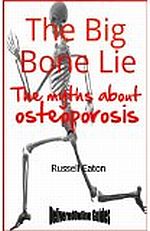 Contrary to the medical marketing hype, synthetic hormonal drugs, dairy products
and most calcium supplements actually weaken the bones and have other harmful effects on health.
Contrary to the medical marketing hype, synthetic hormonal drugs, dairy products
and most calcium supplements actually weaken the bones and have other harmful effects on health.
In a report published in the New England Journal of Medicine the U.S. Food and
Drug Administration raised concerns about the potential for some serious side
effects in women taking bone-building drugs called bisphosphonates, specifically
Fosamax, Actonel and Reclast.
The published findings are not new. In 2011,
the agency voiced concerns that taking the drugs long-term may actually make
bones weaker and increase the risk of serious side effects such as atypical fractures
of the thigh bone, esophageal cancer and osteonecrosis of the jaw, a rare but painful
condition in which the jaw bone crumbles. To investigate, the FDA reviewed data from
women who had taken the drugs for six to 10 years.
Researchers believe that
bisphosphonates not only suppress bone resorption, but also interfere with new bone formation.
This effect is seen only after bisphosphonates have been used
for more than five years. Studies of Fosamax were cleverly stopped
after four to six years. This is just the point at which the fracture
rate for women taking similar drugs began to rise. Now doctors worry
that staying on the drug for more than five years can cause some women's
bones to become more brittle. Merck & Co. is facing legal fire related to its
osteoporosis drug Fosamax. Plaintiffs allege that long-term
Fosamax use causes osteonecrosis of the jaw, a rare type of jawbone degeneration.
Women are constantly bombarded with the message that the war on bone
loss must include calcium supplements and a daily consumption of calcium-rich
foods , primarily dairy products. Board-certified cardiologist, Thomas E. Levy,
offers scientific proof that the regular intake of dairy and calcium supplementation
promotes all known chronic degenerative diseases and significantly shortens life
Osteoporosis: The Dairy Product Myth
Study shows that women who got the most calcium from dairy products
actually broke more bones than women who rarely drank milk.
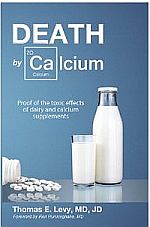 The dairy industry spends several billion dollars each year trying
to convince you that you can't live without your two glasses of pasteurized,
homogenized milk each day. The fact
is that animal protein inhibits the absorption of calcium. Women from
third world countries who have a very low calcium intake combined with
a low intake of animal protein, including dairy, have much less of an
incidence of osteoporosis.
The dairy industry spends several billion dollars each year trying
to convince you that you can't live without your two glasses of pasteurized,
homogenized milk each day. The fact
is that animal protein inhibits the absorption of calcium. Women from
third world countries who have a very low calcium intake combined with
a low intake of animal protein, including dairy, have much less of an
incidence of osteoporosis.
Dr. Susan E. Brown, PhD - "... Hip fracture rates vary 30-fold around
the world, with some cultures being almost immune to osteoporotic
fractures. Cultures with the highest calcium intake have the
highest osteoporosis rates. Further, in many countries, such
as Germany and China, people have lower bone density than we do, yet they fracture much less than we do in the US.
Study show that women who got the most calcium from dairy
products actually broke more bones than women who rarely drank
milk. Although many people think of calcium in the diet as good
protection for their bones, this is not at all the whole story.
In fact, in a 12-year Harvard study of 78,000 women, those who
got the most calcium from dairy products actually broke more
bones than women who rarely drank milk. Similarly, a 1994 study
of elderly men and women in Sydney, Australia, showed that higher
dairy product consumption was associated with increased fracture
risk. Those with the highest dairy product consumption had approximately
double the risk of hip fracture compared to those with the lowest consumption.
To protect your bones you do need calcium in your diet, but you also need to keep calcium in your bones.
Many scientific studies have shown an assortment of detrimental health effects directly
linked to milk consumption. And the most surprising link is that not
only do we barely absorb the calcium in cow's milk (especially if pasteurized),
but to make matters worse, it actually increases calcium loss from the bones.
A 1994 study of elderly men and women in Sydney, Australia,
showed that higher dairy product consumption was associated
with increased fracture risk. Those with the highest dairy product
consumption had approximately double the risk of hip fracture
compared to those with the lowest consumption. To protect your
bones you do need calcium in your diet, but you also need to keep calcium in your bones.
Dr. Susan E. Brown, PhD - "... Hip fracture rates vary 30-fold around the world, with
some cultures being almost immune to osteoporotic fractures. Cultures
with the highest calcium intake have the highest osteoporosis rates.
Further, in many countries, such as Germany and China, people have lower
bone density than we do, yet they fracture much less than we do in the
US. "
 A study to determine the effects of milk
consumption on the calcium metabolism of healthy postmenopausal women
funded by the National Dairy Council showed that drinking three 8-ounce
glasses of low fat milk a day for one year failed to create a positive
calcium balance in these women. Magnesium Deficiency Can Seriously Impact Your
Bones and your Health. It is much better to supplement with magnesium, and eat minimal
animal protein after menopause.
A study to determine the effects of milk
consumption on the calcium metabolism of healthy postmenopausal women
funded by the National Dairy Council showed that drinking three 8-ounce
glasses of low fat milk a day for one year failed to create a positive
calcium balance in these women. Magnesium Deficiency Can Seriously Impact Your
Bones and your Health. It is much better to supplement with magnesium, and eat minimal
animal protein after menopause.
Like all animal protein, milk acidifies the body pH which
in turn triggers a biological correction. Calcium is an excellent acid
neutralizer and the biggest storage of calcium in the body is in the
bones. The very same calcium that our bones need to stay strong is utilized
to neutralize the acidifying effect of milk. Once calcium is pulled
out of the bones, it leaves the body via the urine, so that the surprising
net result after this is an actual calcium deficit.
Chronic Acidosis and Osteoporosis
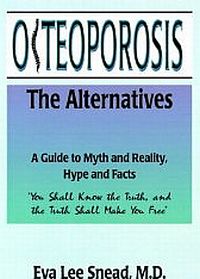 A seven-year study conducted at the University of California, San Francisco,
on 9,000 women showed that those who have
chronic acidosis are at greater risk for bone loss than those who have
normal pH levels. The scientists who carried out this experiment believe
that many of the hip fractures prevalent among middle-aged women are
connected to high acidity caused by a diet rich in animal foods and
low in vegetables. This is because the body borrows calcium from the
bones in order to balance pH.
The cells of the body in health are alkaline.
In disease the cell pH is below 7.0. The more acid the cells become,
the sicker we are and feel. We can remain in health by consuming a diet
that is 70-80% alkaline and 20-30% acid. Most
raw-foods diets are predominantly
alkaline forming foods.
A seven-year study conducted at the University of California, San Francisco,
on 9,000 women showed that those who have
chronic acidosis are at greater risk for bone loss than those who have
normal pH levels. The scientists who carried out this experiment believe
that many of the hip fractures prevalent among middle-aged women are
connected to high acidity caused by a diet rich in animal foods and
low in vegetables. This is because the body borrows calcium from the
bones in order to balance pH.
The cells of the body in health are alkaline.
In disease the cell pH is below 7.0. The more acid the cells become,
the sicker we are and feel. We can remain in health by consuming a diet
that is 70-80% alkaline and 20-30% acid. Most
raw-foods diets are predominantly
alkaline forming foods.
Osteoporosis From Fluoride in the Water, Mouth Wash and Toothpaste
Scientists at EPA in Washington have declared that there is every reason to believe that
the increasing numbers of people with osteoporosis, carpal-tunnel syndrome and arthritis-like pains are due to the mass
fluoridation of drinking water.
Soft drinks are high in phosphoric acid and sugar, making
these drinks highly acidic. Calcium is the main mineral utilized by
the body to neutralize that acid. So phosphoric acid or high amounts
of other acids depletes calcium levels, causing calcium to be pulled
from the bones. Calcium is pulled out of the body when this happens,
and this lowers blood calcium levels. To remedy this, the parathyroid
gland restores calcium balance in the blood by pulling calcium from
your bones. Consequently, anything highly acidic like soft drinks can
directly lead to osteoporosis.

Natural Alternative Programs for the Prevention and Recovery of Bone Loss
 Glutathione is shown to be highly effective in increasing
the formation of osteoblasts - which increase bone density, and reduce
the amount of osteoclasts that adsorb bones. The researchers were looking
at why estrogen deficiency causes bone loss, and noted that when they
removed the ovaries from rats, stopping the production of estrogen,
the levels of glutathione fell sharply. When they administered estrogen,
the levels rapidly returned to normal.
Glutathione is shown to be highly effective in increasing
the formation of osteoblasts - which increase bone density, and reduce
the amount of osteoclasts that adsorb bones. The researchers were looking
at why estrogen deficiency causes bone loss, and noted that when they
removed the ovaries from rats, stopping the production of estrogen,
the levels of glutathione fell sharply. When they administered estrogen,
the levels rapidly returned to normal.
Next, the researchers looked for an alternative to estrogen (as it
is so unhealthy in the drug form) to stop the bone loss. They administered
nutritional precursors of glutathione (which is what Immunocal does
better than anything) and found that these stopped and reversed the
bone loss in those rats. To prove the glutathione link to bone loss,
they administered a specific inhibitor of glutathione synthesis which
induced substantial bone loss.
The conclusions from this study are that estrogen, at least in great
part, prevents bone loss by stimulating formation of active sulfur-based
antioxidants (glutathione) in bone osteoclasts. Adequate levels of glutathione
inhibit osteoclast production and over activity, but doesn't harm the osteoclast
cells, like drugs might. Glutathione had the same bone loss preventing
effect as estrogen. Glutathione keeps osteoclast function in proper
balance, and evidently through the same mechanism as estrogen. When
estrogen is low or nonexistent, osteoclasts spin out of balance because
the body loses its ability to manufacture glutathione in these cells.
Magnesium plays important role in building strong bones
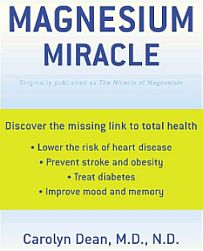 Magnesium stimulates parathyroid hormone and calcitonin, two hormones that prevent bone thinning," says Dr. Dean.
"Getting 320 mg. of magnesium daily could prevent osteoporosis altogether."
Doctors, too, stress the importance of calcium to their older patients
trying to avoid bone loss and osteoporosis. But a physician at the Keck
School of Medicine of USC is looking one rung beyond calcium in the
periodic table of the elements: magnesium. Magnesium seems to
play a role in keeping bones healthy, said Robert Rude, USC professor
of medicine.
Magnesium stimulates parathyroid hormone and calcitonin, two hormones that prevent bone thinning," says Dr. Dean.
"Getting 320 mg. of magnesium daily could prevent osteoporosis altogether."
Doctors, too, stress the importance of calcium to their older patients
trying to avoid bone loss and osteoporosis. But a physician at the Keck
School of Medicine of USC is looking one rung beyond calcium in the
periodic table of the elements: magnesium. Magnesium seems to
play a role in keeping bones healthy, said Robert Rude, USC professor
of medicine.
Epidemiological studies looking at bone health and diet have found
that the more magnesium people consume in their food, the denser their
bones. Dr. Carolyn Dean discusses in her very important book
The Miracle of Magnesium, magnesium deficiency is a significant factor -- often the major factor
-- in many other severe illnesses including heart attacks and other
forms of heart disease, asthma, anxiety and panic attacks, depression,
fatigue, diabetes, migraines and other headaches,
osteoporosis, insomnia, and most cases
of muscular problems. Unfortunately, the majority of Americans are deficient
in magnesium to some degree and many are severely deficient. Because
magnesium deficiency is largely overlooked by orthodox medical doctors,
millions of Americans suffer needlessly from the foregoing ailments
or are having their symptoms treated with expensive drugs (which often
have unpleasant or dangerous side effects) when they could be cured with magnesium supplementation.
Chlorophyll and
green vegetables contain large amounts of magnesium.
Fruits and Vegetable Diet
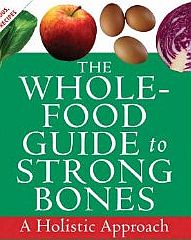 Raw Fruits and vegetables are
rich in several nutrients that appear to play important roles in bone
health, including potassium, magnesium, and vitamin K. Several epidemiological
studies have found that higher intakes of fruits and vegetables, particularly
those rich in potassium, are associated with higher BMD and lower risk
of fracture in older adults. Fruits and vegetables are rich in precursors
to bicarbonate ions, which can preserve calcium in bones by buffering
organic acids consumed in the diet or generated metabolically. The Dietary
Approaches to Stop Hypertension (DASH) studies have also reported that
high fruit and vegetable intake may improve bone health.
Raw Fruits and vegetables are
rich in several nutrients that appear to play important roles in bone
health, including potassium, magnesium, and vitamin K. Several epidemiological
studies have found that higher intakes of fruits and vegetables, particularly
those rich in potassium, are associated with higher BMD and lower risk
of fracture in older adults. Fruits and vegetables are rich in precursors
to bicarbonate ions, which can preserve calcium in bones by buffering
organic acids consumed in the diet or generated metabolically. The Dietary
Approaches to Stop Hypertension (DASH) studies have also reported that
high fruit and vegetable intake may improve bone health.
Originally
designed to test the effect of diet on blood pressure, the DASH trial
compared three diets: a control diet that provided only 3 servings of
fruits or vegetables, a diet that provided about
8 servings of fruits or vegetables, and a diet that provided 8 servings
of fruits or vegetables and 3 servings of low-fat dairy products (now
called the DASH diet). In addition to lowering blood pressure, both
fruit- and vegetable-rich diets reduced urinary calcium loss, and the
DASH diet lowered biochemical markers of bone turnover, particularly
bone resorption (loss). Taken together, the results of epidemiological
and clinical trials suggest that a diet rich in fruits and vegetables
that contains adequate calcium and vitamin D may help prevent bone loss.
Eat a minimum of 5 servings of a variety of different colored fruits
or vegetables daily. Teenage and adult women should aim for at least
7 servings, while teenage and adult men should aim for 9 servings (the
equivalent of 2 1/2 cups of vegetables and 2 cups of fruit).
Vitamin D and Sunlight
Although it has long been known that severe vitamin D deficiency
adversely affects bone health, recent research suggests that marginal
vitamin D deficiency is common and increases the risk of osteoporosis.
When vitamin D is metabolized to its most active form, it increases
the intestinal absorption of calcium and prevents urinary calcium loss.
Without sufficient vitamin D, calcium absorption is not efficient enough
to satisfy the body's needs, even when calcium intake is adequate.
Vitamin D is synthesized in the skin when exposed to ultraviolet-B
(UVB) radiation from sunlight
and can be obtained from the diet. Very little UVB radiation reaches
the earth above 37 degrees of latitude from November through February,
so people who live north of 37 degrees produce little if any vitamin
D during late fall and winter (see map). The application of sunscreen
with an SPF factor of 8 reduces skin production of vitamin D by 95%
even in summer. The ability to synthesize vitamin D in the skin also
decreases with age. A 70-year-old makes only 25% of the vitamin D made
by a 20-year-old exposed to the same amount of sunlight.
Dr. Lee's 3 Osteoporosis Myths
Dr. John Lee MD - "Estrogen's Deadly
Truth: a story of deception, betrayal, hidden agendas, propaganda and
misinformation. I saw these patients who were on estrogen and they were
getting swollen breasts and fibrosistic breast disease, they were getting
fat around their middle, their hips, their abdomen, losing libido and
getting depressed."
Myth #1: Osteoporosis is an estrogen-deficiency
disease . Not even basic medical texts agree with this.
It is a fabrication of the pharmaceutical industry with no
scientific evidence to support it. Osteoporosis begins long
before estrogen levels fall, and accelerates for a few years
at menopause. Taking estrogen can slow bone-loss for those
few years, but its effect wears off within a few years after
menopause. Most importantly, estrogen cannot rebuild new bone.
Osteoporosis was intentionally exploited by the drug companies
in the mid-1970's as compelling reason for women to take HRT.
(In 1976 two studies reported that estrogen replacement therapy
caused an 800% increase in endometrial cancer in the previous 10 years).
To convince women to return to using these steroid hormone treatments
an intentional advertising campaign was launched to scare women back
to hormones. Up until that time, osteoporosis was a relatively unknown
condition by the public. It took a while but the campaign ultimately was
successful. Osteoporosis was perceived as primarily a woman's disease. Menopause and
estrogen deficiency were seen as the culprits and, Hormone
Replacement Therapy was deemed the primary solution. Madison Avenue does it again!!
Myth #2: Osteoporosis is a calcium-deficiency
disease . Most women with osteoporosis are getting plenty of
calcium in their diet. It is quite easy to get the minimum daily
requirement of calcium in even a relatively poor diet. The truth
is that osteoporosis is a disease of excessive calcium-loss caused
by many factors. In osteoporosis, calcium is being lost from the
bones faster than it is being added, regardless of how much calcium
a woman consumes. Good bone health comes down to eating a nutrient
rich diet (it has now proven that organic foods have a higher nutritional
content), including regular weight-bearing exercise, reducing the
toxic and heavy metal load, reducing stress ( adrenal exhaustion
leads to bone loss), having strong digestion in order to properly
digest and assimilate nutrients and hormonal balance.
Myth #3: Osteoporosis is a disease of menopause. This is at least a decade short of the truth.
Osteoporosis begins anywhere from five to 20 years prior to menopause, when estrogen
levels are still high. Osteoporosis accelerates at menopause or
when a woman's ovaries are surgically removed or become non-functional,
such as can happen after hysterectomy. It is staggering to think
how many thousands or millions of women have been doomed to a crippled
old age or early death because their ovaries and/or uterus were
unnecessarily removed before menopause and natural progesterone
replacement was ignored. It used to be thought that all women
have a considerable decrease in bone at menopause from lower estrogen
levels - thus estrogen deficiency was said to be the cause of osteoporosis.
Continuing research has disproved this idea. Studies following individual
women's bone density over time have shown that although some women
lose a lot of bone with menopause, other lose comparatively little, Also,
for some women, bone loss starts before menopause. One study using
urine tests to measure calcium loss found that some women are "fast
losers" and others are naturally "normal losers." Dr. Jerilynn Prior,
researcher and professor of endocrinology at the University of British
Columbia has conducted research that seriously challenges estrogen's
key role in preventing bone loss. Her research confirmed that estrogen's
role in combating osteoporosis is only a minor one. In her study
of female athletes, she found that osteoporosis occurs to the degree
that the athlete's became progesterone deficient, even though their
estrogen levels remained normal.
The Root Cause of Osteoporosis
When millions of people around the
world start experiencing the same health problems, something is seriously wrong. Something is unbalanced.
And it's never an "accident". What scientists have now discovered is...
that the Root Cause of Osteoporosis is the modern lifestyle, causing
your body to become diseased by acids, sugars, carbohydrates, excess
fats and uric acid (all very common in our modern diets) keep flowing
through our bloodstream.
Therefore, any condition is merely a warning
sign of a breakdown in your body due to your lifestyle that takes you
out of balance this is when you develop "Osteoporosis." And if you don't
stop the attacks on your body, you develop even more serious conditions
and eventually truly life-threatening health problems. The radical change
in diet and lifestyle in the last 100 years has actually transformed
your body into a toxic wasteland.
Understand Osteoporosis
"To understand osteoporosis it is important to know a bit about
bones. Bone-forming cells are of two different kinds. One type are called
osteoclasts, and their job is to travel through the bone in search of old bone
that is in need of renewal. Osteoclasts dissolve bone and leave behind tiny
unfilled spaces. Osteoblasts move into these spaces in order to build new bone.
A lack of estrogens, as experienced at menopause, indirectly stimulates the
growth of osteoclasts, thus increasing the risk for developing osteoporosis.
HRT containing estrogen should therefore help prevent osteoporosis.
From this point of view it does. However, osteoclast cells have been shown
to have no estrogen receptors in themselves, so cannot directly build new bone.
On the other hand, osteoblast cells, which are responsible for making new bone,
have been shown to have not estrogen but progesterone receptors. What this
means is that it is progesterone (the natural form, not the synthetic progestins),
not estrogen, which is responsible for building bone tissue. This view is upheld
in the Scientific American Updated Medicine Text 1991, which states, "Estrogens
decrease bone resorption, but associated with the decrease in bone resorption
is a decrease in bone formation. Therefore, estrogen should not be expected to
increase bone mass."
The authors also discuss estrogen side-effects,
including the risk of endometrial cancer which "is increased six-fold in women
who receive estrogen therapy for up to five years; the risk is increased to
fifteen-fold in long-term users." Dr. Kitty Little from Oxford found masses of
tiny clots in the bones of rabbits treated with hormones. She is convinced
that HRT in the form of estrogen and progestins will increase the risk of
osteoporosis. Blood clots originate from sticky clumps of platelet cells in
the blood. She believes that blood clots in the bones can cause bone to
break down, leading to osteoporosis.
More and more research findings are emerging that challenge the
estrogen-deficiency/osteoporosis relationship and reinforce the
progesterone-deficiency link. The results of a three-year study of
63 post-menopausal women with osteoporosis verify this. Women
using transdermal progesterone cream experienced an average 7 to 8
per cent bone-mass density increase in the first year, 4 to 5 per cent
in the second year, and 3 to 4 per cent in the third year! Untreated women
in this age category typically lose 1.5 per cent bone-mass density per year!
These results have not been found with any other form of hormone
replacement therapy or dietary supplementation!